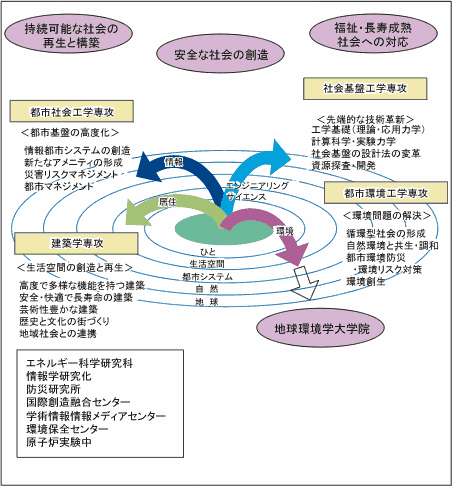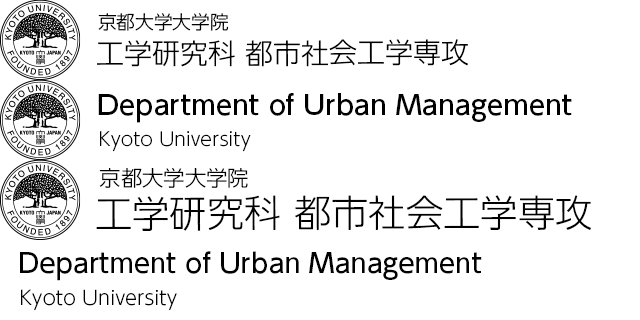History
The Department of Urban Management was founded in 2003 through restructuring of the former civil-engineering departments (Department of Civil Engineering and Department of Civil Engineering Systems) and the Department of Environmental Engineering. Details of this restructuring are given below.
The civil-engineering departments and the Department of Environmental Engineering, from which the Department of Urban Management was formed, originated from the Department of Civil Engineering of Kyoto Science and Engineering University, which was founded in 1897. These departments were founded at the very beginning of Kyoto University.
The Undergraduate School of Civil Engineering at the time of its establishment consisted of three courses: Bridge Engineering, Railway Engineering, and Sanitary Engineering. Since then, the department has steadily upgraded its curriculums in accordance with the demands of time. The Department of Sanitary Engineering was founded in 1958. In 1974, the Department of Civil Engineering ran 12 courses.
With the reconstruction of Japan after World War Two and the development of the industrial economy at this time, there was a need for broad-based research and education on transportation and civil engineering, covering roads, railways, seaports, and airports. Thus, in 1963, the Department of Transportation and Civil Engineering, the first school of its kind in Japan, was founded, which ran six courses. Around the same time, in 1962, the civil engineering departments and the Department of Sanitary Engineering were founded in the Graduate School of Kyoto University.
The civil engineering departments and the Department of Environmental Engineering (from which the Department of Urban Management would later be an offshoot) were recreated in 1996 when the university was restructured to place more emphasis on its graduate schools. These were based on the civil engineering departments in the undergraduate and graduate school, as well as the sanitary engineering departments in the undergraduate and graduate schools. In addition, in a 1996 restructuring of the Faculty of Engineering, the civil engineering-related undergraduate departments were merged with the undergraduate Department of Sanitary Engineering and Department of Resources Engineering to form the Department of Global Engineering.
Scientific and technological developments are starting to have an alarming impact on a variety of environments in society. In order to achieve sustainable development of human society it is critical to establish recycling-oriented communities where people can conserve and utilize the natural environment. At the same time, the development of information technology is driving increasing sophistication in a variety of systems that support society. It is therefore necessary to create a new society in which software, including systems, knowledge and information systems, as well as such hardware as facilities and buildings are developed and integrated.
In order to address new issues effectively and also quickly, in 2003 the civil engineering departments and the Department of Environmental Engineering, along with the Department of Resources Engineering, the Department of Global Environmental Engineering, and the architecture departments were restructured into three departments—the Department of Civil and Earth Resources Engineering, the Department of Urban and Environmental Engineering, and the Department of Urban Management.
The diagram below shows these three departments and their related organizations, as well as the directions to which they are moving.

Chronology
|
April 2003 |
Engineering departments, the Department of Environmental Engineering, Department of Resources Engineering, Department of Global Environmental Engineering, and the architecture departments were restructured into three departments—the Department of Civil and Earth Resources Engineering, the Department of Urban and Environmental Engineering, and the Department of Urban Management. |
|---|
